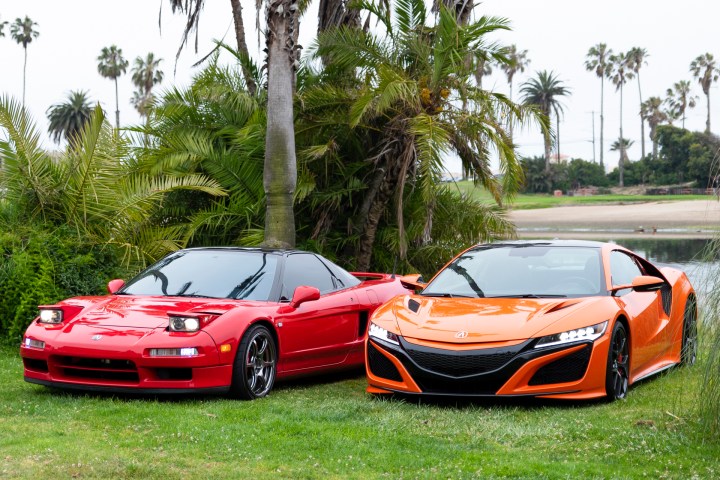
Nobody likes the new Acura NSX. Well it’s not that nobody likes it, it’s that nobody is buying one. This of course means nobody likes it enough to part with their retirement savings to get one. And what are people pilfering their 401Ks for? The old NSX, that’s what. The classic NSX’s values have doubled over the last 6 years, and images of the cars are currently adorning countless walls, garages, and phone screens everywhere.
They (and “they” here means the automotive press at large) say the new one, while great to drive, is too convoluted. That it’s V6 engine isn’t big enough. That the new car is too slow compared to the competition that it was reportedly benchmarked against. That the current NSX is not nearly pretty enough. They don’t like that it took 20 years to get to us, and that their inflated expectations weren’t met.
Those lofty expectations were set by the aforementioned original NSX. The first-generation Acura NSX rewrote the performance playbook when it debuted in 1991, making cutting edge engineering available outside the dealerships with names like Ferrari and Porsche on the building. The classic NSX’s aluminum construction, advanced suspension set up, and exotic mid-engine design shocked the world because they were attached to an Acura badge. Because of its otherworldly engineering and peerless dynamics on the road, the old NSX is now on a pedestal so high that its company includes the air-cooled 911 and Jaguar E-type. In other words, it’s now regarded as a classic all-time great driver’s car.
For every positive you hear about the original NSX, there is an equal and opposite reaction for the new model. Call it Newton’s 3rd law of reboots. Everyone loves the driving dynamics of the new car, but feel it missed the mark set by the original in important ways. The complaints generally center around the looks (“bland”), the paltry engine (“just a V6”), and the complicated hybrid setup compared to the original’s purer layout. Overall, the consensus is that the new Acura NSX drives very well, but it lacks that ephemeral “character” that imbued the original NSX.
They are wrong. Everyone is wrong here. The new NSX is exactly like the old NSX.
I’m not just taking a contrarian view to get your clicks. The similarities between the cars go far beyond the badge, and I believe this new model is a future classic. I think that because I’ve actually done the research (shocker!) and compared the reviews of the original NSX to the reviews floating around for the new model. They might as well be interchangeable.
The classic NSX brought Japanese reliability and common sense to the sports car.
When the 1991 model debuted, there were a litany of complaints that sound eerily familiar to the protesting about today’s car. Once again, while very fun to drive, the car had a “mere 270 hp.” And it made “only 210 pound-feet of torque at 5300 rpm.” These are “Respectable numbers, but not extraordinary.” It was “Fast, but not a record setter.” The bodywork was “not truly distinctive.” Finally, “who wants to have to explain to the Ferrari-owning cardiologist at the country club why you bought a $70,000 Honda?”
And yet today the classic model is venerated. Why? Because neither version of the NSX were built to the world’s mundane expectations. Neither is supposed to be the numbers king in 0-60 or top speed. Nor are they designed to out-pretty a Pininfarina creation. Both have a solitary and devilishly concentrated purpose: To democratize cutting edge technology and use that tech to create a driver’s car capable of going to toe-to-toe with exotics that are double the price. That’s it.
The original car brought aluminum construction, a mid-engine layout, and driving dynamics that heretofore were only available from punishing and unwieldly sports cars that were as much a challenge to drive as they were a reward. That is what made is special in the 90’s. At them time, most exotics were very hard to drive, and near impossible to live with because they were so fragile. The classic NSX brought Japanese reliability and common sense to the sports car. That is a legacy the new car continues.
The new car has the same hybrid tech of the McLaren P1, the Porsche 918 Spyder, and the LaFerrari and brings it to the people. This is a hybrid system built not for eco-gloating, but to enable the car to be faster, quicker, and more enjoyable to drive. The new NSX showcases how an electric future can end up helping the internal combustion engine.
Because of the hybrid system and the Acura-ness of the car, the new NSX is a fantastic ride. It can carve a canyon road, and it can easily be parked or navigated through traffic. That has always been the NSX’s party piece. Classic or new, both use their Honda-ness to their best ability and make a car that is easy when you want it to be easy and rewarding when we want it to be rewarding. This is why the new NSX will be a future classic. It’s accessible, it has advanced technology, and most importantly it’s an absolute blast to drive. And that last fact is an area where all of auto journalism is in agreement. Despite the kvetching about the this or that, we all agree that this is a great car to drive and is very able to plaster a smile across your face.

When the old NSX debuted, it was shocking at $60,000. The new NSX is a steal at $155,000 for the level of performance and technology that you get. And where the first car had to deal with the fact that it was “only an Acura,” brands only pay that particular tax once. The first one paved the way for this NSX to be accepted at its price point. And when compared to what else you are getting into at $150k, it’s shocking that the NSX isn’t flying off dealership lots.
Nobody is buying the current the NSX, but the old one struggled to sell in 90’s as well. After an initial flurry of sales – dealers marking up the cars by 100% was not unheard of, and Japan even instituted a lottery to buy one – a recession hit and sales completely dried up. Today we have no recession to contend with, but Acura only sold 170 NSXs in 2018. Anyone walking past an NSX to get into an Audi R8 or Porsche 911 Turbo is making a huge mistake. The modern NSX will be just as revered in the future as the original one is now, and because it is selling far fewer, they are only going to be more valuable. If I haven’t convinced you yet, there is also a rumor of an R-type NSX coming out soon …











